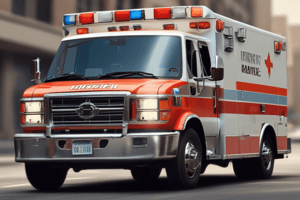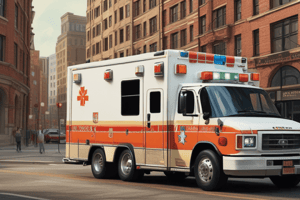Podcast
Questions and Answers
What are the phases of an ambulance call? (Select all that apply)
What are the phases of an ambulance call? (Select all that apply)
- En route to receiving facility (correct)
- Back in service (correct)
- Prep for call (correct)
- Patient assessment
Before the first call, you should check the ______.
Before the first call, you should check the ______.
vehicle, equipment, comms
What are the primary responsibilities of an EMS?
What are the primary responsibilities of an EMS?
Personal safety, patient assessment, patient care based on assessment findings, lifting and moving, transport, transfer
The 4 second rule refers to maintaining a safe following distance.
The 4 second rule refers to maintaining a safe following distance.
What is the most common type of accident for EMS vehicles?
What is the most common type of accident for EMS vehicles?
If toxic gases or other hazards are expected, where should you park?
If toxic gases or other hazards are expected, where should you park?
When hazards are involved, what should you do?
When hazards are involved, what should you do?
Which of the following are types of communication systems used in EMS? (Select all that apply)
Which of the following are types of communication systems used in EMS? (Select all that apply)
Study Notes
Phases of Ambulance Call
- Preparation for the call includes ensuring all necessary equipment and personnel are ready.
- Dispatching involves formal notification of the call to the responding unit.
- The en route phase is when EMS personnel travel to the call location.
- Upon arrival at the scene, assessment and actions must be taken promptly.
- Transfer of the patient to the ambulance for transport is a critical step.
- En route to the receiving facility involves maintaining patient care and monitoring.
- "Back in service" indicates the unit is ready for the next call after completing the current one.
Before First Call
- Conduct a thorough check of the vehicle, equipment, and communication systems to ensure operational readiness.
Primary Responsibilities
- Personal safety is the top priority during all operations.
- Patient assessment is crucial to determine the appropriate care needed.
- Provide patient care based on findings from assessments.
- Techniques for lifting and moving patients safely are essential.
- Transport and transfer of the patient must be executed with caution and care.
4 Second Rule
- Maintaining a safe following distance is vital, using a minimum of four seconds to gauge distance between vehicles.
Most Common Accidents for EMS Vehicles
- Intersections are identified as high-risk areas for accidents involving EMS vehicles.
Toxic Hazards Protocol
- In cases where toxic gases, liquids, or other hazards are anticipated, vehicles should park 100 feet uphill and upwind to ensure safety.
Hazard Communication
- Notify the receiving facility about any hazards involved so that the staff can prepare adequately for the arrival of the patient.
Communication Systems
- Effective communication relies on various systems including:
- Base station radio for centralized communications.
- Mobile two-way radios for communication while on the move.
- Handheld radios for direct, portable communication.
- Repeater systems to enhance signal strength over distances.
- Biotelemetry for transmitting patient data remotely.
- Computerized mobile data terminals for real-time information access and updates.
Studying That Suits You
Use AI to generate personalized quizzes and flashcards to suit your learning preferences.
Description
Test your knowledge on the various phases of an ambulance call and the essential responsibilities of EMS personnel. This quiz covers preparation, dispatching, patient assessment, and operational readiness. Assess your understanding of these critical emergency medical service protocols.




